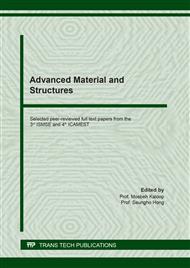[1]
E.M. Ahmed, Hydrogel: Preparation, characterization, and applications: A review, J. Adv. Res., 6 (2015) 105–121.
Google Scholar
[2]
D.E. Ciolacu, D.M. Suflet, Cellulose-based hydrogels for medical/pharmaceutical applications, in: V. Popa, I. Volf (Eds.), Biomass as Renew. Raw Mater. to Obtain Bioprod. High-Tech Value, Elsevier, 2018: p.401–439.
DOI: 10.1016/b978-0-444-63774-1.00011-9
Google Scholar
[3]
Q. Chai, J. Yang, X. Yu, Hydrogels for biomedical applications: Their characteristics and the mechanisms behind them, Gels, 3 (2017) 6.
Google Scholar
[4]
S. Cascone, G. Lamberti, Hydrogel-based commercial products for biomedical applications: A review, Int. J. Pharm., 573 (2020) 118803.
DOI: 10.1016/j.ijpharm.2019.118803
Google Scholar
[5]
J. Zhu, R.E. Marchant, Design properties of hydrogel tissue-engineering scaffolds, Expert Rev. Med. Devices, 8 (2011) 607–626.
DOI: 10.1586/erd.11.27
Google Scholar
[6]
P. Gurikov, I. Smirnova, Non-conventional methods for gelation of alginate, Gels, 4 (2018).
DOI: 10.3390/gels4010014
Google Scholar
[7]
M. Łabowska, I. Michalak, J. Detyna, Methods of extraction, physicochemical properties of alginates and their applications in biomedical field – a review, Open Chem., 17 (2019) 738–762.
DOI: 10.1515/chem-2019-0077
Google Scholar
[8]
S. Sharmeen, M.S. Rahman, M.M. Islam, M.S. Islam, M. Shahruzzaman, A.K. Mallik, P. Haque, M.M. Rahman, Application of polysaccharides in enzyme immobilization, in: S. Maiti, S. Jana (Eds.), Funct. Polysaccharides Biomed. Appl., Elsevier, 2019: p.357–395.
DOI: 10.1016/b978-0-08-102555-0.00011-x
Google Scholar
[9]
F.E. Freeman, D.J. Kelly, Tuning alginate bioink stiffness and composition for controlled growth factor delivery and to spatially direct MSC Fate within bioprinted tissues, Sci. Rep., 7 (2017) 1–12.
DOI: 10.1038/s41598-017-17286-1
Google Scholar
[10]
K. Mikula, D. Skrzypczak, B. Ligas, A. Witek-Krowiak, Preparation of hydrogel composites using Ca2+ and Cu2+ ions as crosslinking agents, SN Appl. Sci., 1 (2019) 1–15.
DOI: 10.1007/s42452-019-0657-3
Google Scholar
[11]
N. Yang, R. Wang, P. Rao, L. Yan, W. Zhang, J. Wang, F. Chai, The fabrication of calcium alginate beads as a green sorbent for selective recovery of Cu(Ⅱ) from metal mixtures, Crystals, 9 (2019) 255.
DOI: 10.3390/cryst9050255
Google Scholar
[12]
J. Jang, Y.J. Seol, H.J. Kim, J. Kundu, S.W. Kim, D.W. Cho, Effects of alginate hydrogel cross-linking density on mechanical and biological behaviors for tissue engineering, J. Mech. Behav. Biomed. Mater., 37 (2014) 69–77.
DOI: 10.1016/j.jmbbm.2014.05.004
Google Scholar
[13]
M. Matyash, F. Despang, C. Ikonomidou, M. Gelinsky, Swelling and mechanical properties of alginate hydrogels with respect to promotion of neural growth, Tissue Eng. Part C, 20 (2014) 401–411.
DOI: 10.1089/ten.tec.2013.0252
Google Scholar
[14]
N.R. Richbourg, N.A. Peppas, The swollen polymer network hypothesis: Quantitative models of hydrogel swelling, stiffness, and solute transport, Prog. Polym. Sci., 105 (2020) 101243.
DOI: 10.1016/j.progpolymsci.2020.101243
Google Scholar
[15]
Á. Serrano-Aroca, J.F. Ruiz-Pividal, M. Llorens-Gámez, Enhancement of water diffusion and compression performance of crosslinked alginate films with a minuscule amount of graphene oxide, Sci. Rep., 7 (2017).
DOI: 10.1038/s41598-017-10260-x
Google Scholar
[16]
T. Andersen, P. Auk-Emblem, M. Dornish, 3D Cell Culture in Alginate Hydrogels, Microarrays, 4 (2015) 133–161.
DOI: 10.3390/microarrays4020133
Google Scholar
[17]
S. Derakhshanfar, R. Mbeleck, K. Xu, X. Zhang, W. Zhong, M. Xing, 3D bioprinting for biomedical devices and tissue engineering: A review of recent trends and advances, Bioact. Mater., 3 (2018) 144–156.
DOI: 10.1016/j.bioactmat.2017.11.008
Google Scholar
[18]
F. You, X. Wu, X. Chen, 3D printing of porous alginate/gelatin hydrogel scaffolds and their mechanical property characterization, Int. J. Polym. Mater. Polym. Biomater., 66 (2017) 299–306.
DOI: 10.1080/00914037.2016.1201830
Google Scholar
[19]
P.S. Gungor-Ozkerim, I. Inci, Y.S. Zhang, A. Khademhosseini, M.R. Dokmeci, Bioinks for 3D bioprinting: an overview, Biomater. Sci., 6 (2018) 915–946.
DOI: 10.1039/c7bm00765e
Google Scholar
[20]
S. Ahn, H. Lee, G. Kim, Functional cell-laden alginate scaffolds consisting of core/shell struts for tissue regeneration, Carbohydr. Polym., 98 (2013) 936–942.
DOI: 10.1016/j.carbpol.2013.07.008
Google Scholar
[21]
A. Rajaram, D.J. Schreyer, D.X.B. Chen, Use of the polycation polyethyleneimine to improve the physical properties of alginate-hyaluronic acid hydrogel during fabrication of tissue repair scaffolds, J. Biomater. Sci. Polym. Ed., 26 (2015) 433–445.
DOI: 10.1080/09205063.2015.1016383
Google Scholar
[22]
Y. Yoon, C.H. Kim, J.E. Lee, J. Yoon, N.K. Lee, T.H. Kim, S.H. Park, 3D bioprinted complex constructs reinforced by hybrid multilayers of electrospun nanofiber sheets, Biofabrication, 11 (2019).
DOI: 10.1088/1758-5090/ab08c2
Google Scholar
[23]
M.B. Huglin, D.C.F. Yip, An alternative method of determining the water content of hydrogels, Die Makromol. Chemie, Rapid Commun., 8 (1987) 237–242.
DOI: 10.1002/marc.1987.030080506
Google Scholar
[24]
M. Llorens-Gámez, Á. Serrano-Aroca, Low-cost advanced hydrogels of calcium alginate/carbon nanofibers with enhanced water diffusion and compression properties, Polymers (Basel)., 10 (2018) 405.
DOI: 10.3390/polym10040405
Google Scholar
[25]
G. Li, G. Zhang, R. Sun, C.P. Wong, Mechanical strengthened alginate/polyacrylamide hydrogel crosslinked by barium and ferric dual ions, J. Mater. Sci., 52 (2017) 8538–8545.
DOI: 10.1007/s10853-017-1066-x
Google Scholar
[26]
J. Kurowiak, A. Kaczmarek-Pawelska, A.G. Mackiewicz, R. Bedzinski, Analysis of the Degradation Process of Alginate-Based Hydrogels in Artificial Urine for Use as a Bioresorbable Material in the Treatment of Urethral Injuries, Processes, 8 (2020) 304.
DOI: 10.3390/pr8030304
Google Scholar
[27]
S. Saitoh, Y. Araki, R. Kon, H. Katsura, M. Taira, Swelling/deswelling mechanism of calcium alginate gel in aqueous solutions, Dent. Mater. J., 19 (2000) 396–404.
DOI: 10.4012/dmj.19.396
Google Scholar
[28]
H.A. Oualid, O. Amadine, Y. Essamlali, K. Dânoun, M. Zahouily, Supercritical CO2 drying of alginate/zinc hydrogels: A green and facile route to prepare ZnO foam structures and ZnO nanoparticles, RSC Adv., 8 (2018) 20737–20747.
DOI: 10.1039/c8ra02129e
Google Scholar


